| |
|
Gabriele D'Annunzio or d'Annunzio (ennobled by the King of Italy in 1924 as Principe di Montenevoso) was an Italian poet, journalist, novelist, dramatist, and daredevil. His role in politics is controversial due to his influence on the Italian Fascist movement and his status as the alleged forerunner of Benito Mussolini.
The richly sensuous imagery of even his early poetry — Le primavere della mala pianta [the springtime of the evil plant] (1880) and Canto nuovo [new song] (1882) — displayed his unrivaled literary craftsmanship. His novels — Il piacere (1889, tr. The Child of Pleasure, 1898), L'innocente (1892, tr. The Intruder, 1898, and The Victim, 1914), Giovanni Episcopo (1892, tr. Episcopo & Company, 1896), and Il trionfo della morte (1894, tr. The Triumph of Death, 1896) — show the same creative handling of the Italian language, but the works are shallow and theatrical.
The outbreak of World War I found him in France, where he had lived since 1910. He returned to Italy, where his oratory had much to do with persuading Italy to join the Allies, and fought with spectacular daring in the air force. In Sept., 1919, he led an expedition (known as the march on Ronchi) against Fiume, where he established a rule opposed by both the Italian government and the rest of Europe, which lasted until Jan., 1921. His troops in the Fiume raid introduced the black shirt that was to be the uniform of the fascists.
D'Annunzio, one of the few writers to be courted by Mussolini, was an early exponent of Fascism. His book Notturrno (1921) is a moving analysis of sensations and memories during weeks of blindness from which he partially recovered. He added little in later life to the long list of his works. His plays include Il sogno d'un mattino di primavera (1897, tr. The Dream of a Spring Morning, 1902), Il sogno d'un tramonto d'autunno (1898, tr. The Dream of an Autumn Sunset, 1904), La città morta (1898, tr. The Dead City, 1902), and Francesca (1902, tr. Francesca da Rimini, 1902). Most of these were written during the time of his love affair with Eleonora Duse, which he described with cruel candor in the novel Il fuoco (1900; tr. The Flame of Life, 1900). Mussolini appointed him (1937) president of the Royal Italian Academy, but he died before taking office.
D'Annunzio's paramour, the actress Eleonara Duse, died of tuberculosis in Pittsburgh in 1924. During her nine years in Settignano she officially lived at Via della Capponcina 75 in the Villa Porziuncola, once owned by Michelangelo. Michelangelo, as a child, also lived at Via della Capponcina 68, in a house owned by his father Leonardo Buonarroti who run a stone quarry nearby.
In 1910 D'Annunzio was forced to sell La Capponcina where he had lived since 1899. He moved to France, settling finally in Arcachon.
He came back to Italy only five years later to take part in the events that were going to weigh on the course of history and unwillingly inspire Mussolini – who D’Annunzio secretly despised.
One of his most recent biographers, John Woodhouse, summarizes the writer’s character in one paragraph:
D’Annunzio’s sole concern was self-gratification and glory: to make his existence as interesting and preferably as joyful as possible for himself, whatever the consequences for others; to create a work of art from his life and to immortalize it in words. There were, it is true, moments when nationalism or patriotism seemed important … but more often than not the greater glory of his native land served only to throw into greater relief the lustre of his personal brand of glory.
The War strengthened his ultra-nationalist and irredentist views, and he campaigned widely for Italy to assume a role alongside her wartime allies as a first-rate European power. Angered by the proposed handing over of the city of Fiume (now Rijeka in Croatia) whose population was mostly Italian, at the Paris Peace Conference, on 12 September 1919, he led the seizure by 2,000 Italian nationalist irregulars of the city, forcing the withdrawal of the inter-Allied (American, British and French) occupying forces.[ H.R. Kedward, Fascism in Western Europe 1900-45, p 40 New York University Press New York, 1971]
After the Fiume episode, D'Annunzio retired to his home on Lake Garda and spent his latter years writing and campaigning. Although D'Annunzio had a strong influence on the ideology of Benito Mussolini, he never became directly involved in fascist government politics in Italy, being temporarily crippled and shocked after an attempted murder in 1922. Shortly before the march on Rome, he was pushed out of a window by an unknown assailant, surviving but badly injured, and did not completely recover before Mussolini had been appointed Prime Minister and hailed by the fascists as duce del fascismo.
In 1924 he was ennobled by King Victor Emmanuel III and given the hereditary title of Principe di Montenevoso. In 1937 he was made president of the Royal Academy of Italy. D'Annunzio died in 1938 of a stroke, at his home in Gardone Riviera. He was given a state funeral by Mussolini and was interred in a magnificent tomb constructed of white marble at Il Vittoriale degli Italiani.
|
|
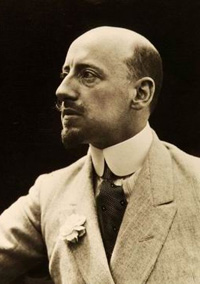
Gabriele D'Annunzio
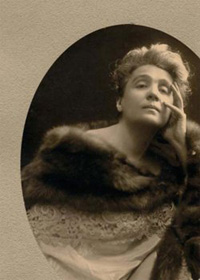
Eleonora Duse
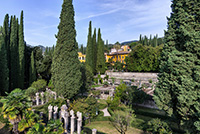
Il Vittoriae degli Italiani
|
| Near Settignano are the Villa Gamberaia, a 14th-century villa famous for its 18th-century terraced garden. |
|
|
|
|
| |
|

[1] The Lover of Eleonora Duse | 'Few streets in Florence are named for women. One of these, Viale Eleonora Duse, crosses Viale Gabriele D’Annunzio near the foot of the Settignano hill. The city fathers, in their wisdom, have thus romantically united, as they were in reality for a decade, two of the most famous Italian figures of the late 19th century.
Eleonora Duse was one of the two most famous European actresses of the era. When not touring, Duse lived in a modest villa, La Porziuncola, Via della Capponcina 75, in Settignano, in the hills above Florence. D’Annunzio had conveniently rented the more grandiose villa La Capponcina, for which he could not afford the rent and which Duse paid for him, at Via della Capponcina 32, living there in princely splendor with his 38 borzoi dogs, 10 horses, 15 servants, and 200 doves. Michelangelo, as a child, also lived at Via della Capponcina 68, in a house owned by his father Leonardo Buonarroti who run a stone quarry nearby.
The short distance between the two villas, on opposite sides of the same street, gave the lovers ample opportunity to see each other. D’Annunzio remained in the lavishly furnished villa even after his affair with Duse floundered in 1904. He lived there from 1898 until 1908, when, as Duse was no longer paying his bills and he lived mostly on credit, he was forced to flee into “exile” in France to escape creditors haunting him for payment.
The affair between D’Annunzio and Duse started with an exchange of correspondence. Duse had just read D’Annunzio’s novel L’Innocente and was attempting to convince him to write a play for her. After reading his next novel, Il Trionfo della Morte, Eleonora’s fascination with D’Annunzio became a morbid fixation, since she was fascinated and at the same time repelled by the author’s energetic but strange ideas. She confided to Boito: “I would prefer to die in a corner rather than love a soul such as his. I detest D’Annunzio, but adore him.”
The two had met in 1894 in Venice. The affair, which started in 1895, lasted on and off for close to a decade. The relationship was mutually advantageous, since Duse paid most of D’Annunzio’s bills, and he wrote four plays in which she starred.
The personal relationship was a tortured one, since the egotistical D’Annunzio saw Duse merely as an outlet, but not an exclusive one, for his sexual acrobatics, a source of funds to pay for his expensive tastes, and a glamorous and respectable publicity vehicle for his plays. Additionally, the depth of their intimacy provided him material for his novels.
We mostly know of the turmoil of their relationship from the nearly 1,500 letters Eleonora Duse wrote him, which are conserved in the archives of D’Annunzio’s residence-museum in Gardone Riviera. Her letters are full of love, but also visions of professional dreams and descriptions of her increasing reliance on her work to forget his frequent slights and escapades, and on opium for her increasing solitude. D’annunzio was not keenly aware of, or else did not care for, Duse’s emotionality. He was frenetically active, both writing and engaging in intimate relationships with other women, even using stimulants to stay awake, saying, “The heraldic flags of glory are insomnia and activism.”
D’Annunzio’s letters to Duse are no longer extant since apparently her daughter Enrichetta Marchetti Bullough destroyed them in England after Duse’s death. The poet was apparently incredulous and perturbed when he learned of this and sent Enrichetta a telegram which said, in part: “The destruction of my letters to Ghisola [his nickname for Duse] is an unjustifiable crime against the spirit. Those many pages were the highest testimony of nobility for my loved one and myself. It is not true that she gave you orders to destroy them. I swear it is not true. She is always next to me and speaks to me without words…”
In 1897, D’Annunzio wrote the play Sogno di una Mattina di Primavera, in which Duse starred in Rome. When the play did not do well, D’Annunzio blamed Duse and moved to Paris, where he started to pay assiduous attention to Sarah Bernhardt, Eleonora’s rival on the world’s theatrical stage.
The two actresses worked on stage in totally different manners: Bernhardt was old school and her superb acting was the result of long experience and exaggerated but expressive stage gestures; Duse was an instinctive actress who detested gesturing and conveyed her characters’ essence by living their emotions and being able to transmit them to the audience. Bernhardt was also very adept in the favorable use of publicity and relished it, while Duse rarely gave interviews and when not on stage avoided publicity and the press.
Anton Chekhov, the Russian playwright, commented that Duse was the greater actress: Bernhardt’s success was due to hard work, Duse’s to talent. George Bernard Shaw, who saw them both in June 1895 acting the same role in the same play in London, also gave his vote to Duse as the better actress. In one of his most enthusiastic reviews, Shaw, who had already praised Duse for “the best modern acting I have ever seen,” wrote that she had inflicted “annihilation on her rival…” He added that the Italian, “with a tremor of the lip, which you feel rather than see, and which lasts half an instant, touches you straight on the very heart,” and concluded that Duse “immeasurably dwarfs the poor little octave and a half on which Sarah Bernhardt plays such pretty canzonets and stirring marches.” Constantin Stanislavski, Lee Strasberg, and Charlie Chaplin – all were vocal in their praise of Duse.
D’Annunzio gave Bernhadt the lead part in his new play La Citta Morta even though it had been written and promised to Duse, who in 1896 had undertaken a new tour in the United States to raise the money to stage it. The tour had been a triumph, and in Washington President Grover Cleveland and his wife attended all her performances. The First Lady even went so far as to invite Duse for tea, a first at the White House for an actress, and had thus shocked the staid Washington society.
In 1900 D’Annunzio, by now bored with his lover (now 37 to Duse’s 42), in his novel Il Fuoco revealed in the intimate, somewhat fictionalized details about their affair. And though the break was definitive, she would not admit that her love had ended, as she wrote with reference to the publication of Il Fuoco: “My pain, whatever it is, does not count when we are talking about another masterpiece of Italian literature. Further, I am forty-one years old …and I love (him).”
Still more slights followed. In March 1904 D’Annunzio deprived Duse of the main role in his new play La Figlia di Iorio, which he’d also written for her, and for which she had already had costumes made. He sent a messenger to pick up the costumes, telling her in a note: “ The theater is a monster that devours its children; you must let yourself be devoured.” The role was then given to the younger Irma Grammatica. D’annunzio wrote in his secret notebook, “Fleeting infidelity gives love an inebriating novelty,” and “going down the old streets of Fiesole I would arrive at the gate of a villa barred by a gate…” where “two sisters expert in perverse pleasures” waited for him. He would return from such excursions, sometimes lasting two or three days, in great spirits and charged with boundless energy.
Poor Duse was at wit’s end about how to keep her philandering lover from straying. Once, while he was out, she arrived at his villa unannounced, searched the bed and found two hairpins, proof that the poet was taking women to the bed they had shared. In a jealous, hysterical rage, she went about looking for matches so that she could burn La Capponcina. A veterinarian who was at the villa treating some of the animals reminded her that no one in the villa smoked, and hence there were no matches.
Duse, although she still loved D’Annunzio, was finally losing patience. She sent him a note telling him off: “…Do not talk to me of the supremacy of rationality, of your life of the flesh, of you thirst (for glory), of a life of joy. I am tired of these words! I have listened to you parroting them for years… Do not answer this…”
On April 5, 1924, in Pittsburgh, Pennsylvania, walking from the hotel to the theater, she was caught in a rainstorm. That night she came down with high fever and never recovered, dying on Easter Monday, April 21 at the age of 66.
Although she was buried in Asolo, her wishes concerning the private character of the funeral were not respected, since her death and funeral became a political issue. Learning of her sickness, D’Annunzio did not rush to his former lover’s side, but soon after she died telegraphed Benito Mussolini, the prime minister, urging that the remains of the “most Italian of hearts” be brought back to Italy by the government. Although the appeal was couched in personal terms, D’Annunzio was likely seeking publicity for himself, since he gave copies of the telegram to the press and the text was published throughout the world. Now that she was gone, D’Annunzio also appeared devastated by remorse and, truthful for once, said, “The one whom I did not deserve has died.”
In his older days, D’Annunzio kept a veil over the face of a Duse bust sculpted when they lived together and claimed that he could communicate with her spirit while biting a pomegranate standing in front of a statue of the Buddha.'
[Source: Luciano Mangiafico , Nine Ways of Looking at D’Annunzio | www.openlettersmonthly.com ]
References
Luciano Mangiafico , Nine Ways of Looking at D’Annunzio | www.openlettersmonthly.com
Bibliography
Wingless Victory: A Dual Biography of Gabrie D'Annunzio and Eleanora Duse by F. Winwar (1956)
D'Annunzio: The Poet as Superman by A. Rhodes (1960)
Gabriele D'Annunzio in France by G. Gullace (1966)
D'Annunzio by P. Jullian (1972); The First Duce by M.A. Ledeen (1977)
The Italian Stage from Goldoni to D'Annunzio by M. Carlson (1981)
Gabriele D'Annunzio by C. Klopp (1988)
Gabriele D'Annunzio by Charles Klopp (1988)
Decadent Genealogies: The Rhetoric of Sickness from Baudelaire to D'Annunzio by Barbara Spackman (1989)
Gabriele D'Annunzio: The Dark Flame by Paolo Valesio, et al (1992)
D'Annunzio and the Great War by Alfredo Bonadeo (1995)
Nationalism and Culture: Gabriele D'Annunzio and Italy After the Risorgimento by Jared M. Becker (1995)
Gabriele D'Annunzio: Defiant Archangel by John Woodhouse (1998)
|

One of the best places to slow travel is Tuscany, with its exquisite art, museums and churches in small hillside villages, the cuisine and epic countryside.
Podere Santa Pia is a peaceful retreat, perfect for relaxing and enjoying the splendor of the Tuscany countryside. Enjoy the exquisite art, museums and churches in the nearby cities, then relish the cuisine and epic countryside. The most interesting artistic, historical and cultural sites of southern Tuscany are nearby, and are awaiting your discovery.
Podere Santa Pia highlights the best of the quintessential Italian region.
Hidden secrets in Tuscany | Holiday house Podere Santa Pia |
| |
|
|
|
|
|
|
|
|
|
|
| Wine regions |
|
Podere Santa Pia |
|
Podere Santa Pia, view from the garden
on the valley below
|
| |
|
|
|
|
|
|
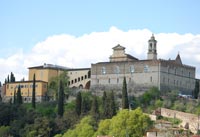 |
|
|
Villa Gamberaia |
|
Certosa del Galluzzo (Firenze) |
|
Villa I Tatti
|
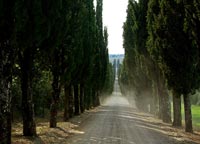 |
|
|
|
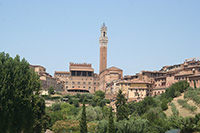
|
Villa Arceno gardens |
|
Abbey of Sant 'Antimo |
|
|
| |
|
|
|
|
Settignano
|
Settignano is a picturesque frazione ranged on a hillside northeast of Florence, Italy, with spectacular views that have attracted American expatriates for generations. The little borgo of Settignano carries a familiar name for having produced three sculptors of the Florentine Renaissance, Desiderio da Settignano and the Gamberini brothers, better known as Bernardo Rossellino and Antonio Rossellino. The young Michelangelo lived with a sculptor and his wife in Settignano—in a farmhouse that is now the "Villa Michelangelo"— where his father owned a marble quarry. In 1511 another sculptor was born there, Bartolomeo Ammanati. The marble quarries of Settignano produced this series of sculptors.
Roman remains are to be found in the borgo which claims connections to Septimius Severus—in whose honor a statue was erected in the oldest square in the 16th century, destroyed in 1944— though habitation here long preceded the Roman emperor. Settignano was a secure resort for estivation for members of the Guelf faction of Florence. Giovanni Boccaccio and Niccolò Tommaseo both appreciated its freshness, among the vineyards and olive groves that are the preferred setting for even the most formal Italian gardens.
Mark Twain and his wife stayed at the Villa Viviani in Settignano from September 1892 to June 1893, and greatly enjoyed their visit. Twain was very productive there, writing 1,800 pages including a first draft of Pudd'nhead Wilson. He said the villa "afford[ed] the most charming view to be found on this planet."
|
|
 Settignano, visto da Corbignano |

|
|
|
| 1 | A Walk Around the Uffizi Gallery
2 | Quarter Duomo and Signoria Square
3 | Around Piazza della Repubblica
4 | Santa Maria Novella
5 | San Niccolo Neighbourhood in Oltrarno
6 | Walking in the Bargello Neighbourhood
7 | From Fiesole to Settignano
There are several recommended itineraries for the healthy walker or runner. The most idyllic start is at the bridge, Ponte a Mensola, at the junction of the Via Vincigliata and the Via Gabriele d'Annunzio.
That Settignano is a state of mind more than a blowsy Baroque monument is confirmed by the legend of the bridge and its stream: in Boccaccio's poem ''Ninfale Fiesolana'' a shepherd, Africo, falls in love with a nymph, Mensola, who bears him a child and is punished by the jealous goddess of chastity, who turns Mensola into a stream.
Following the stream along the Via Vincigliata to the Via Corbignano, one finds two marble plaques of the major artists and writers who were born or lived in and around Settignano.
Leonardo da Vinci tried to fly with his batlike flying machine in Settignano; in 1505 he launched it off nearby Monte Ceceri. Certainly the best pagan celebration of Settignano is Giovanni Boccaccio's ''Decameron,'' a series of earthy tales of a group of merrymakers, refugees from the plague that killed a third of Florence in 1348. Boccaccio's father's house was in Corbignano, a hamlet below Settignano. The revelry is supposed to have taken place in the neighboring Castello Poggio Gherardo. Six hundred years later, in 1971, the book was made into a film by Pierpaolo Pasolini, who directed it in the same immutable vineyards.
Berenson, one day after seeing oxen dragging a plow through these sloping fields, tried to analyze his happiness: ''The spectacle in itself was beautiful. At the same time it gave me a feeling that I was looking at what has been going on ever since civilization began, and is likely to go on for a good while yet in Mediterranean lands, where, owing to terracing, the agriculture of the great American and Russian plains would be unsuitable. To think of dragging tractors through terraced Tuscan 'podere'!''
References
Twain, Mark, The £1,000,000 Bank Note and Other New Stories, introd. by Malcolm Bradbury (The Oxford Mark Twain, Oxford U. Press, 1996)
Susan Lumsden, A Village of Cypress and Vines | www.nytimes.com
|
|
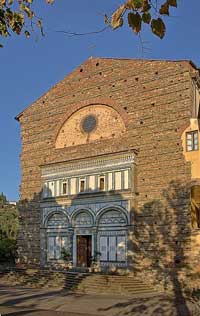 Fiesole, facade Badia fiesolana Fiesole, facade Badia fiesolana
Via della Badia leads to the Badia Fiesolana, the town's cathedral until 1028.
|
This article incorporates material from the Wikipedia article Settignano, Florence published under the GNU Free Documentation License. Wikimedia Commons has media related to: Gabriele d'Annunzio.
|
|
|
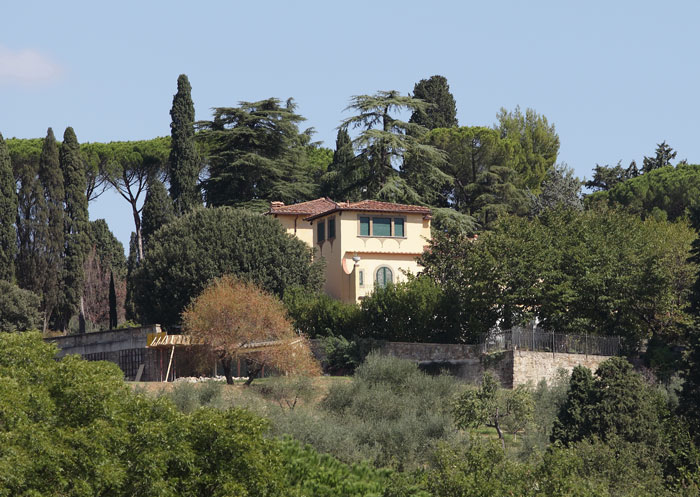






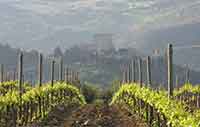


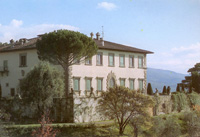
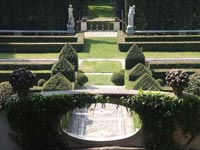
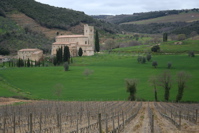


 Fiesole, facade Badia fiesolana
Fiesole, facade Badia fiesolana